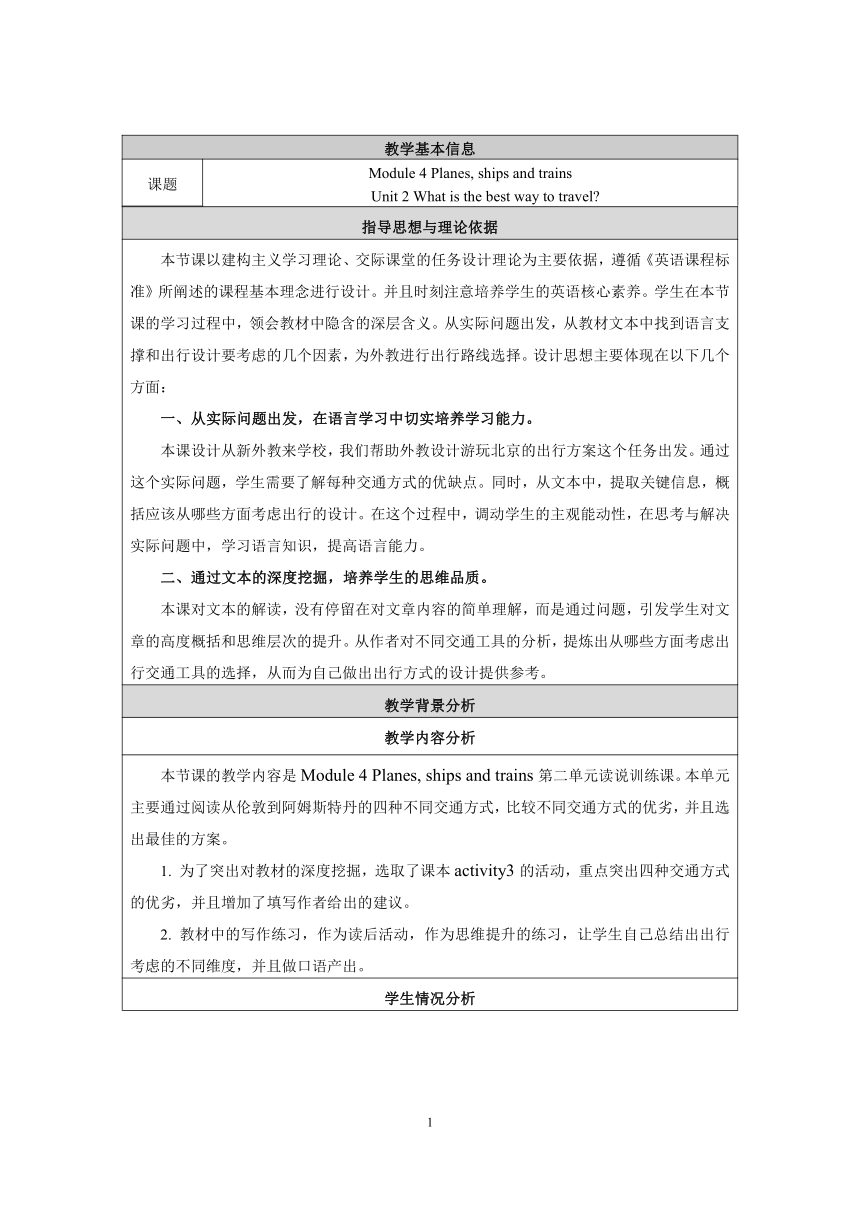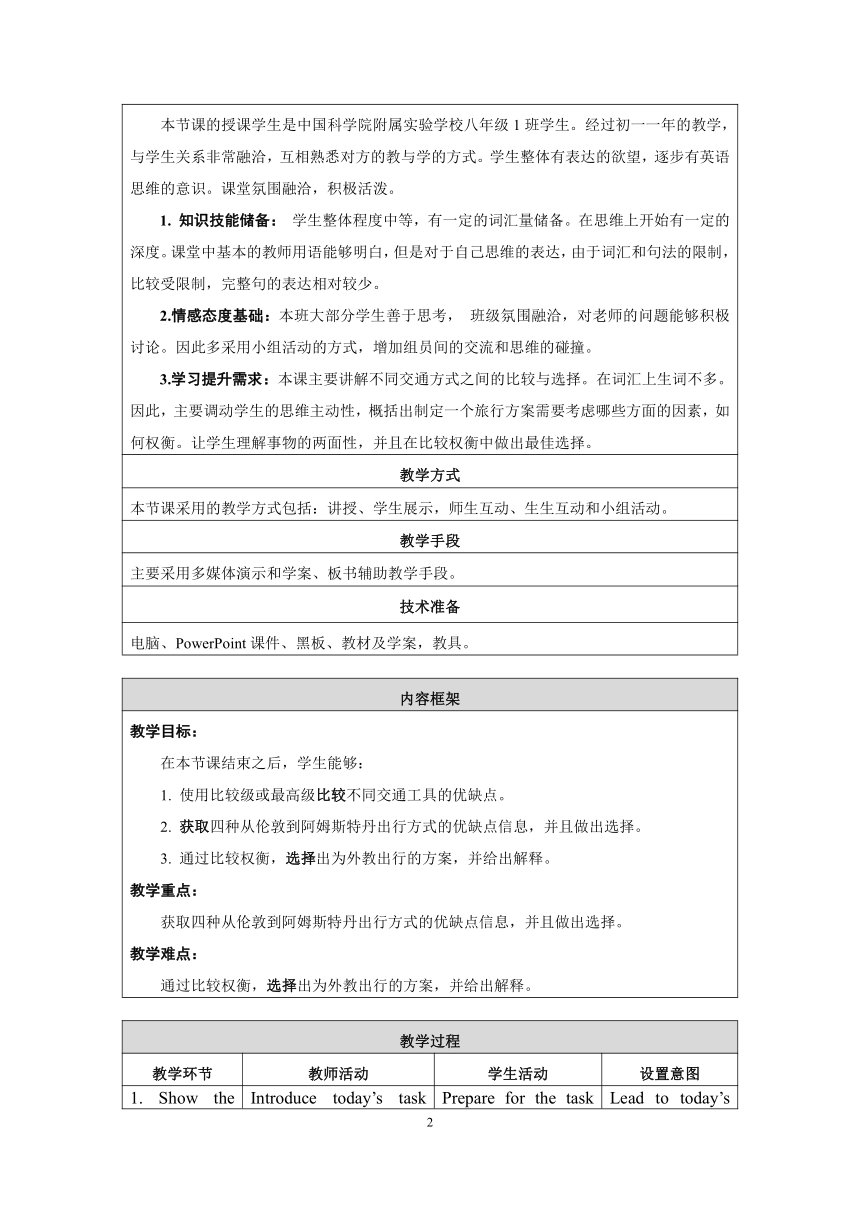Module 4 Unit 2 What is the best way to travel 教案(表格式)
文档属性
| 名称 | Module 4 Unit 2 What is the best way to travel 教案(表格式) |  | |
| 格式 | doc | ||
| 文件大小 | 74.0KB | ||
| 资源类型 | 教案 | ||
| 版本资源 | 外研版 | ||
| 科目 | 英语 | ||
| 更新时间 | 2022-10-23 08:15:38 | ||
图片预览


文档简介
教学基本信息
课题 Module 4 Planes, ships and trainsUnit 2 What is the best way to travel
指导思想与理论依据
本节课以建构主义学习理论、交际课堂的任务设计理论为主要依据,遵循《英语课程标准》所阐述的课程基本理念进行设计。并且时刻注意培养学生的英语核心素养。学生在本节课的学习过程中,领会教材中隐含的深层含义。从实际问题出发,从教材文本中找到语言支撑和出行设计要考虑的几个因素,为外教进行出行路线选择。设计思想主要体现在以下几个方面:一、从实际问题出发,在语言学习中切实培养学习能力。本课设计从新外教来学校,我们帮助外教设计游玩北京的出行方案这个任务出发。通过这个实际问题,学生需要了解每种交通方式的优缺点。同时,从文本中,提取关键信息,概括应该从哪些方面考虑出行的设计。在这个过程中,调动学生的主观能动性,在思考与解决实际问题中,学习语言知识,提高语言能力。二、通过文本的深度挖掘,培养学生的思维品质。本课对文本的解读,没有停留在对文章内容的简单理解,而是通过问题,引发学生对文章的高度概括和思维层次的提升。从作者对不同交通工具的分析,提炼出从哪些方面考虑出行交通工具的选择,从而为自己做出出行方式的设计提供参考。
教学背景分析
教学内容分析
本节课的教学内容是Module 4 Planes, ships and trains第二单元读说训练课。本单元主要通过阅读从伦敦到阿姆斯特丹的四种不同交通方式,比较不同交通方式的优劣,并且选出最佳的方案。1. 为了突出对教材的深度挖掘,选取了课本activity3的活动,重点突出四种交通方式的优劣,并且增加了填写作者给出的建议。2. 教材中的写作练习,作为读后活动,作为思维提升的练习,让学生自己总结出出行考虑的不同维度,并且做口语产出。
学生情况分析
本节课的授课学生是中国科学院附属实验学校八年级1班学生。经过初一一年的教学,与学生关系非常融洽,互相熟悉对方的教与学的方式。学生整体有表达的欲望,逐步有英语思维的意识。课堂氛围融洽,积极活泼。 1. 知识技能储备: 学生整体程度中等,有一定的词汇量储备。在思维上开始有一定的深度。课堂中基本的教师用语能够明白,但是对于自己思维的表达,由于词汇和句法的限制,比较受限制,完整句的表达相对较少。2.情感态度基础:本班大部分学生善于思考, 班级氛围融洽,对老师的问题能够积极讨论。因此多采用小组活动的方式,增加组员间的交流和思维的碰撞。3.学习提升需求:本课主要讲解不同交通方式之间的比较与选择。在词汇上生词不多。因此,主要调动学生的思维主动性,概括出制定一个旅行方案需要考虑哪些方面的因素,如何权衡。让学生理解事物的两面性,并且在比较权衡中做出最佳选择。
教学方式
本节课采用的教学方式包括:讲授、学生展示,师生互动、生生互动和小组活动。
教学手段
主要采用多媒体演示和学案、板书辅助教学手段。
技术准备
电脑、PowerPoint课件、黑板、教材及学案,教具。
内容框架
教学目标:在本节课结束之后,学生能够:1. 使用比较级或最高级比较不同交通工具的优缺点。2. 获取四种从伦敦到阿姆斯特丹出行方式的优缺点信息,并且做出选择。3. 通过比较权衡,选择出为外教出行的方案,并给出解释。教学重点:获取四种从伦敦到阿姆斯特丹出行方式的优缺点信息,并且做出选择。教学难点:通过比较权衡,选择出为外教出行的方案,并给出解释。
教学过程
教学环节 教师活动 学生活动 设置意图
1. Show the task (25 seconds) Introduce today’s task about making the travel plan for our school’s new foreign teacher “Nate”. Prepare for the task and think what we should know to finish the task. Lead to today’s topic and also come into the real situation.
2. Task preparing (9 minutes) Invite some students to introduce the advantages and disadvantages of five kinds of transportation. Take notes and retell the advantages and disadvantages of the transportation. 1) Show the self-study.2) Practice listening ability. 3) Lead to the comparative and superlative of adjectives.
3.Passage reading (Fast-reading)(5 minutes) Read and get the main idea of the passage. Read fast and answer the two questions. 1) Let students know the general ideas of the passage.2) Practice the skimming strategy.
4.Passage reading (detailed reading)(10 minutes) Read and fill the table Read carefully and fill the table. Then discuss in group and retell. 1) Figure out the advantages and disadvantages of four kinds of traveling. 2) Practice scanning ability.
5. Further thinking (1 minute) Further thinking: What aspects should we consider when we plan the ways of travelling. Read the passage again and discuss in group and summarize from what aspects we need to consider the travel planning. Cultivate their deep thinking ability and know how to balance the choices.
6. Task-Finishing and presentation(15 minutes) Choose their own travel route and choose the best way to travel and give the reasons. Discuss in group and talk about the advantages and disadvantages of different ways of travelling. Use the superlative or adjectives to compare and balance different choices and make a better plan.
8.Evaluation Students and teacher give comments on the performance of each group and evaluate. Listen carefully the presentation and give their evaluation. Make evaluation for the performance of their students.
9. Homework(1 minute) 1. Read the passage and retell the four ways to travel. 2. Write down the group’s final plan. 1. Retell the four ways of travelling to their partners. 2. Write down the plan and polish the language. Use the sentence structures they have learned to practice the writing ability.
板书设计
M4: Planes, ships and trains.U2: What is the best way to travel ways of travelling advantage disadvantage train more relaxing more expensivecar and ship the most comfortable the most expensivecoach the cheapest crowdedplane the fastest; the second cheapest; wait
课后反思
1
课题 Module 4 Planes, ships and trainsUnit 2 What is the best way to travel
指导思想与理论依据
本节课以建构主义学习理论、交际课堂的任务设计理论为主要依据,遵循《英语课程标准》所阐述的课程基本理念进行设计。并且时刻注意培养学生的英语核心素养。学生在本节课的学习过程中,领会教材中隐含的深层含义。从实际问题出发,从教材文本中找到语言支撑和出行设计要考虑的几个因素,为外教进行出行路线选择。设计思想主要体现在以下几个方面:一、从实际问题出发,在语言学习中切实培养学习能力。本课设计从新外教来学校,我们帮助外教设计游玩北京的出行方案这个任务出发。通过这个实际问题,学生需要了解每种交通方式的优缺点。同时,从文本中,提取关键信息,概括应该从哪些方面考虑出行的设计。在这个过程中,调动学生的主观能动性,在思考与解决实际问题中,学习语言知识,提高语言能力。二、通过文本的深度挖掘,培养学生的思维品质。本课对文本的解读,没有停留在对文章内容的简单理解,而是通过问题,引发学生对文章的高度概括和思维层次的提升。从作者对不同交通工具的分析,提炼出从哪些方面考虑出行交通工具的选择,从而为自己做出出行方式的设计提供参考。
教学背景分析
教学内容分析
本节课的教学内容是Module 4 Planes, ships and trains第二单元读说训练课。本单元主要通过阅读从伦敦到阿姆斯特丹的四种不同交通方式,比较不同交通方式的优劣,并且选出最佳的方案。1. 为了突出对教材的深度挖掘,选取了课本activity3的活动,重点突出四种交通方式的优劣,并且增加了填写作者给出的建议。2. 教材中的写作练习,作为读后活动,作为思维提升的练习,让学生自己总结出出行考虑的不同维度,并且做口语产出。
学生情况分析
本节课的授课学生是中国科学院附属实验学校八年级1班学生。经过初一一年的教学,与学生关系非常融洽,互相熟悉对方的教与学的方式。学生整体有表达的欲望,逐步有英语思维的意识。课堂氛围融洽,积极活泼。 1. 知识技能储备: 学生整体程度中等,有一定的词汇量储备。在思维上开始有一定的深度。课堂中基本的教师用语能够明白,但是对于自己思维的表达,由于词汇和句法的限制,比较受限制,完整句的表达相对较少。2.情感态度基础:本班大部分学生善于思考, 班级氛围融洽,对老师的问题能够积极讨论。因此多采用小组活动的方式,增加组员间的交流和思维的碰撞。3.学习提升需求:本课主要讲解不同交通方式之间的比较与选择。在词汇上生词不多。因此,主要调动学生的思维主动性,概括出制定一个旅行方案需要考虑哪些方面的因素,如何权衡。让学生理解事物的两面性,并且在比较权衡中做出最佳选择。
教学方式
本节课采用的教学方式包括:讲授、学生展示,师生互动、生生互动和小组活动。
教学手段
主要采用多媒体演示和学案、板书辅助教学手段。
技术准备
电脑、PowerPoint课件、黑板、教材及学案,教具。
内容框架
教学目标:在本节课结束之后,学生能够:1. 使用比较级或最高级比较不同交通工具的优缺点。2. 获取四种从伦敦到阿姆斯特丹出行方式的优缺点信息,并且做出选择。3. 通过比较权衡,选择出为外教出行的方案,并给出解释。教学重点:获取四种从伦敦到阿姆斯特丹出行方式的优缺点信息,并且做出选择。教学难点:通过比较权衡,选择出为外教出行的方案,并给出解释。
教学过程
教学环节 教师活动 学生活动 设置意图
1. Show the task (25 seconds) Introduce today’s task about making the travel plan for our school’s new foreign teacher “Nate”. Prepare for the task and think what we should know to finish the task. Lead to today’s topic and also come into the real situation.
2. Task preparing (9 minutes) Invite some students to introduce the advantages and disadvantages of five kinds of transportation. Take notes and retell the advantages and disadvantages of the transportation. 1) Show the self-study.2) Practice listening ability. 3) Lead to the comparative and superlative of adjectives.
3.Passage reading (Fast-reading)(5 minutes) Read and get the main idea of the passage. Read fast and answer the two questions. 1) Let students know the general ideas of the passage.2) Practice the skimming strategy.
4.Passage reading (detailed reading)(10 minutes) Read and fill the table Read carefully and fill the table. Then discuss in group and retell. 1) Figure out the advantages and disadvantages of four kinds of traveling. 2) Practice scanning ability.
5. Further thinking (1 minute) Further thinking: What aspects should we consider when we plan the ways of travelling. Read the passage again and discuss in group and summarize from what aspects we need to consider the travel planning. Cultivate their deep thinking ability and know how to balance the choices.
6. Task-Finishing and presentation(15 minutes) Choose their own travel route and choose the best way to travel and give the reasons. Discuss in group and talk about the advantages and disadvantages of different ways of travelling. Use the superlative or adjectives to compare and balance different choices and make a better plan.
8.Evaluation Students and teacher give comments on the performance of each group and evaluate. Listen carefully the presentation and give their evaluation. Make evaluation for the performance of their students.
9. Homework(1 minute) 1. Read the passage and retell the four ways to travel. 2. Write down the group’s final plan. 1. Retell the four ways of travelling to their partners. 2. Write down the plan and polish the language. Use the sentence structures they have learned to practice the writing ability.
板书设计
M4: Planes, ships and trains.U2: What is the best way to travel ways of travelling advantage disadvantage train more relaxing more expensivecar and ship the most comfortable the most expensivecoach the cheapest crowdedplane the fastest; the second cheapest; wait
课后反思
1
同课章节目录
- Module 1 How to learn English
- Unit 1 Let's try to speak English as much as possi
- Unit 2 You should smile at her.
- Unit 3 Language in use .
- Module 2 My home town and my country
- Unit 1 It's taller than many other buildings.
- Unit 2 Cambridge is a beautiful city in the east o
- Unit 3 Language in use .
- Module 3 Sports.
- Unit 1 Nothing is more exciting than playing tenni
- Unit 2 This year we training more carefully.
- Unit 3 Language in use .
- Module 4 Planes, ships and trains .
- Unit 1 He lives the farthest from school.
- Unit 2 What is the best way to travel.
- Unit 3 Language in use .
- Module 5 Lao She Teahouse.
- Unit 1 I wanted to see the Beijing Opera.
- Unit 2 It descibes the changes in Chinese society.
- Unit 3 Language in use .
- Module 6 Animals in danger.
- Unit 1 It allows people to get closer to them .
- Unit 2 The WWF is working hard to save them all.
- Unit 3 Language in use .
- Revision module A
- Module 7 A famous story
- Unit 1 Alice was sitting with her sister by the ri
- Unit 2 She was thinking about her cat.
- Unit 3 Language in use .
- Module 8 Accidents
- Unit 1 While the car were changing to red, a car s
- Unit 2 I was trying to pick it up when it bite me
- Unit 3 Language in use .
- Module 9 Population
- Unit 1 The population of China is about 1.37 billi
- Unit 2 Arnwick was a city with 200,000 people.
- Unit 3 Language in use .
- Module 10 The weathe
- Unit 1 It might snow.
- Unit 2 The weather is fine all year round.
- Unit 3 Language in use .
- Module 11 Way of life
- Unit 1 In China ,we open a gift later.
- Unit 2 In England, you usually drink tea with milk
- Unit 3 Language in use .
- Module 12 Help
- Unit 1 What should we do before help arrives?
- Unit 2 Stay away from windows and heavy furniture.
- Unit 3 Language in use .
- Revision module B
